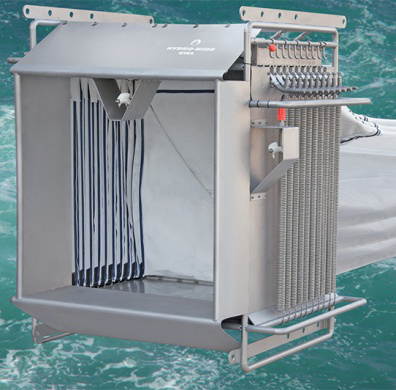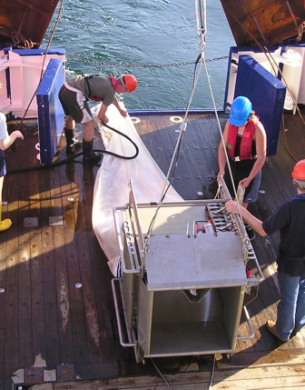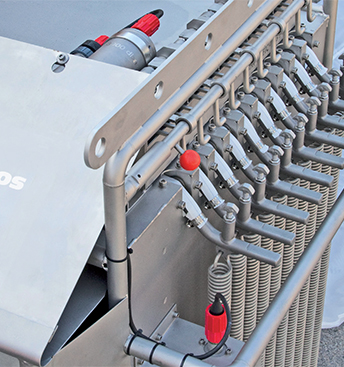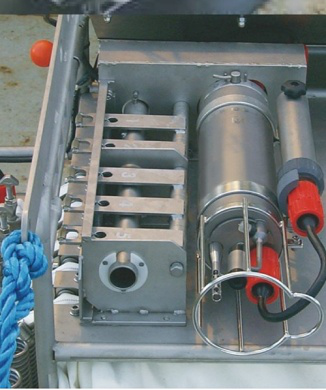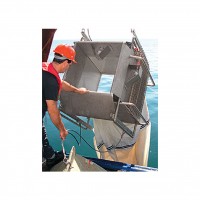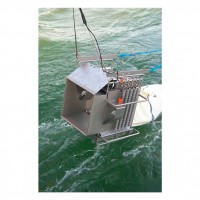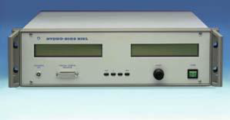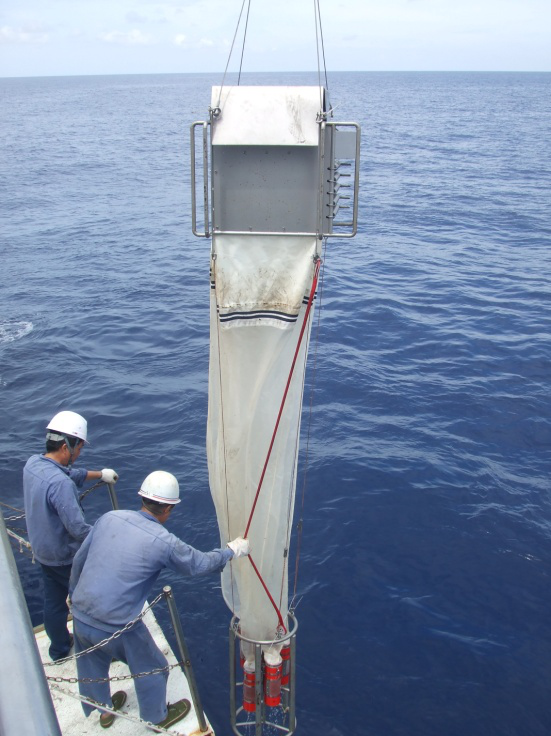德国HYDRO-BIOS公司——浮游生物多联采样网
浮游生物连续采样网MultiNet®
Multi Plankton Sampler MultiNet®
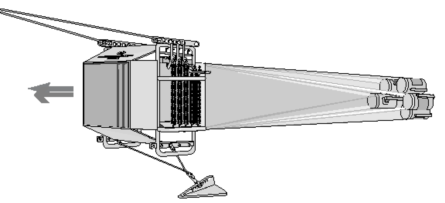
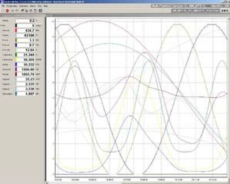
水平操作状态 OceanLab软件
MultiNet®浮游生物采样网介绍:
MultiNet®浮游生物采样网是一款浮游生物自动采样器,浮游生物采样网可以在连续的水层中进行水平采样和垂直采样。每个MultiNet®浮游生物采样网安装5只(9只)网袋。MultiNet®浮游生物采样网开口面积:Mini型,0.125m2;Midi型,0.25m2,Maxi型,0.5m2;Mammoth型,1m2。MultiNet®浮游生物采样网的整个系统由甲板控制单元、水下控制单元、不锈钢框架、网衣、网底管等组成,5(9)只网袋通过拉链连接器连接在不锈钢框架的帆布部分上。
|
|
|
|
每次可采5(9)个水层样品 | 准备入水 | 高强度弹簧提供网口开闭的动力 | 钛合金仓内的高精度步进马达和控制单元 |
MultiNet®浮游生物采样网网袋的开启与关闭是通过一个电池驱动的马达单元激发的。控制网袋开关的指令是通过甲板控制单元和水下单元之间的单芯和多芯电缆传输的。我们可以提供各种网袋,适用于各种标准的和非标准的应用场合。对于常规的水平采样操作,我们推荐您使用孔径为300微米(孔径从100微米至500微米都是可选的)的网袋;对于垂直采样来说,网孔大小从55微米到500微米都是适用的。
MultiNet®浮游生物采样网的水下单元中集成一个压力传感器,深度和所有其他系统相关数据会一起在甲板控制单元的液晶显示屏上显示。水下单元上可以安装两个带有角度补偿功能的电子网口流量计:一个装在水下单元的开口内,用于测定通过网口的水量;另一个装在水下单元开口外,用于测定“堵塞效应”。
在水平采样操作中,MultiNet®浮游生物采样网安装了一个V-Fin深度抑制器;在垂直采样操作时,一个不锈钢支撑安装在网底管固定器上,以便垂直采样时,采样网能够安全迅速地降到所需的深度。
|
|
|
工作中的MultiNet | 甲板单元 | 2010年南海作业 |
MultiNet®浮游生物连续采样网设备特点:
√水平操作和垂直操作
√容易操作
√双向通讯
√标准深度3000米,可选工作深度6000米,11000米
√长距离FSK自动测量记录传导
√电量消耗低
√电池供电的水下单元
√EC-认证(CE)EN 50081-1,EN 50082-1
√操作温度范围-40℃ ~ +85℃
MultiNet®浮游生物连续采样网的操作:
在初始位置的时候,MultiNet®浮游生物连续采样网上的所有网袋是关闭的。水流可以很自由地流过浮游生物连续采样网的框架,并允许采样器以合适的速度降到期望的深度,然后按下甲板单元上的按钮,可以使第1个网袋打开,当操作结束时,可以通过第2个指令将其关闭。在第1个网袋关闭的同时,第2个网袋会接着打开,当甲板单元显示激活的网袋号码时,这些网袋会重复以上过程。在操作Mini型和Midi型MultiNet®浮游生物连续采样网时,第5个网袋保持敞开状态,MultiNet®浮游生物连续采样网会收集从期望深度到表层的浮游生物。在操作Maxi型和Mammoth型MultiNet®浮游生物连续采样网时,第9个网袋可以在到达水面之前闭合。
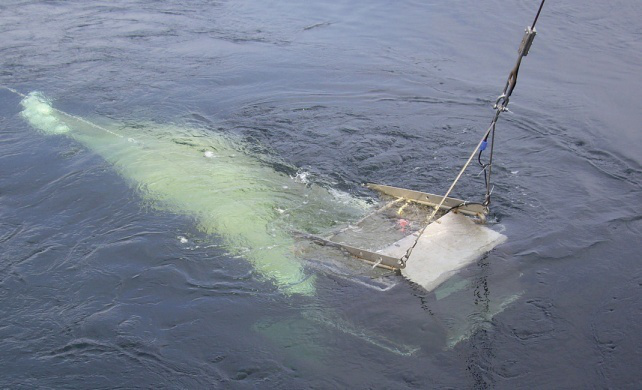
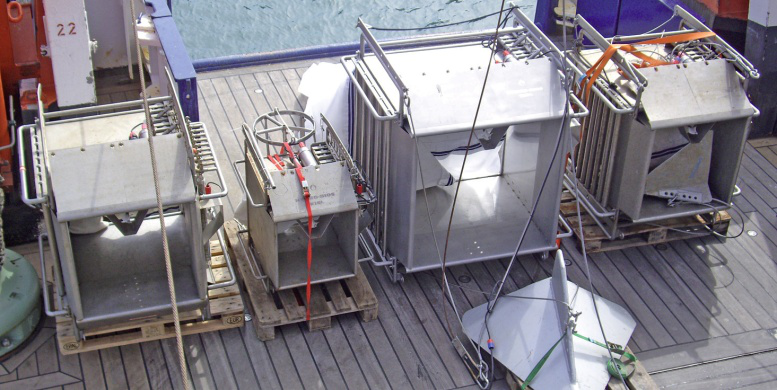
MultiNet浮游生物连续采样网入水姿态 MultiNet浮游生物连续采样网整装待发
MultiNet®浮游生物连续采样网与CT组件:
MultiNet®浮游生物连续采样网与CT组件结合在一起,拥有一台CTD(温盐深仪)的完整功能。CT组件由一个电导率传感器,一个温度传感器和一块附加电路板组成,它们集成在MultiNet®浮游生物连续采样网的马达驱动单元中。根据UNESCO公式,系统可以从获得的CTD数据,计算出盐度、密度和声速等指标。
MultiNet®浮游生物连续采样网的额外选择:
√各种参数的传感器,如盐度、温度、叶绿素a、浊度、姿态传感器等
√电池供电的手持终端,当在线操作没有交流电供电时,用来代替甲板控制单元
√MultiNet®浮游生物连续采样网有适用于6000米和11000米采样的特殊型号
MultiNet®浮游生物连续采样网细节展示:
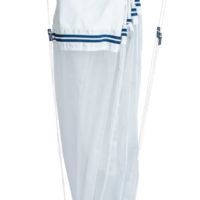
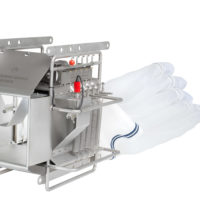
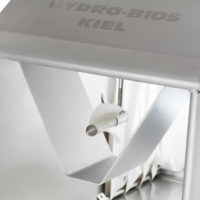
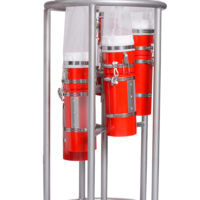
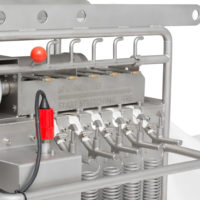
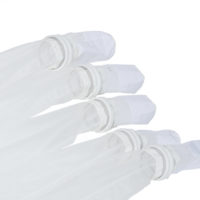
MultiNet®浮游生物连续采样网技术参数:
浮游生物连续采样网MultiNet传感器技术参数
传感器 | 范围 | 精度 | 分辨率 | 耐压水深 |
压力 | 0-3000dbar (0-6000dbar可选) | ±0.1%FS | 0.002% FS | 6000米 |
温度 | -2~+32℃ | ±0.005℃ | 0.0006℃ | 6000米 |
电导率 | 0-65mS/cm | ±0.01mS/cm | 0.0003mS/cm | 6000米 |
叶绿素a | 0-150μg/L | ±2%FS | 0.025μg/l | 6000米 |
浊度 | 0-650 FTU | ±2%FS | 0.1FTU | 6000米 |
四款浮游生物连续采样网MultiNet®详细技术参数对比表
小型Mini | 中型Midi | 大型Maxi | 猛犸象型Mammoth | |
水下单元: | ||||
尺寸: 宽*长*高 | 65*90*80cm | 80*90*95cm | 120*110*135cm | 150*120*160cm |
网开口 | 35.5*35.5cm | 50*50cm | 71*71cm | 100*100cm |
网袋 | 5个/160cm长 | 5个/250cm长 | 9个/365cm长 | 9个/550cm长 |
标准网孔 | 300μm | 300μm | 300μm | 300μm |
网底管 | 5个/直径11cm | 5个/直径11cm | 9个/直径11cm | 9个/直径11cm |
工作时系统总长度 | 470 cm | 560cm | 800cm | 1000cm |
工作深度 | 3000m/6000m/ 11000m | 3000m/6000m/ 11000m | 3000m/6000m/ 11000m | 3000m/6000m/ 11000m |
压力传感器 | 3000dbar±0.1%f.s. (其他范围可选) | 3000dbar±0.1%f.s. (其他范围可选) | 3000dbar±0.1%f.s. (其他范围可选) | 3000dbar±0.1%f.s. (其他范围可选) |
小型Mini | 中型Midi | 大型Maxi | 猛犸象型Mammoth | |
重量: | ||||
网框 | 75kg | 100kg | 260kg | 390kg |
不锈钢支撑 | 30kg | 50kg | 70kg | 100kg |
V-Fin 深度抑制器 | 22Kg | 22Kg | 70Kg | 70Kg |
材质: | ||||
网框 | 不锈钢 | 不锈钢 | 不锈钢 | 不锈钢 |
马达单元 和电池舱 | 钛合金 | 钛合金 | 钛合金 | 钛合金 |
网袋 | 聚酰胺 | 聚酰胺 | 聚酰胺 | 聚酰胺 |
网底管 | PVC | PVC | PVC | PVC |
V-Fin 深度抑制器 | 铝 | 铝 | 铝 | 铝 |
断裂负载: | ||||
浅水工作(0-500m) | 约1500kg | 约2000kg | 约4000kg | 约8000kg |
深水工作(500-3000m) | 约5000kg | 约8000kg | 约12000kg | 约18000kg |
电气连接参数: | ||||
连接插头 | SUBCONN BH 2 M | SUBCONN BH 2 M | SUBCONN BH 2 M | SUBCONN BH 2 M |
电缆反向插头 | SUBCONN IL 2 F | SUBCONN IL 2 F | SUBCONN IL 2 F | SUBCONN IL 2 F |
电缆连接 | 单芯或多芯电缆 | 单芯或多芯电缆 | 单芯或多芯电缆 | 单芯或多芯电缆 |
电缆电阻(回路) | 1000Ω | 1000Ω | 1000Ω | 1000Ω |
甲板控制单元 | 通过按钮控制网袋的闭合,显示网袋序号,压力,电池状态,通过网口的水的流量和流速等;带LED背景光的液晶显示器;与PC连接的RS232接口 | |||
电源: | ||||
水下单元 | 3节3V锂电池供电 | 3节3V锂电池供电 | 3节3V锂电池供电 | 3节3V锂电池供电 |
甲板控制单元 | 85-260V AC | 85-260V AC | 85-260V AC | 85-260V AC |
拖网速度(当网袋的孔径为300μm时): | ||||
水平操作 | ≤4knots | ≤4knots | ≤4knots | ≤4knots |
垂直操作 | ≤1m/s | ≤1m/s | ≤1m/s | ≤1m/s |
资料下载:
相关新闻链接:
国外应用代表文献:
1.Anna Schukat, Lena Teuber, Wilhelm Hagen, Norbert Wasmund, Holger Auel,2013.Energetics and carbon budgets of dominant calanoid copepods in the northern Benguela upwelling system.Journal of Experimental Marine Biology and Ecology.442:1-9.
2.Silke Laakmann, Holger Auel, Marc Kochzius,2012.Evolution in the deep sea: Biological traits, ecology and phylogenetics of pelagic copepods.Molecular Phylogenetics and Evolution.65(2):535–546.
3.Jessica R. Frost, Anneke Denda, Clive J. Fox, Charles A. Jacoby, Rolf Koppelmann, Morten Holtegaard Nielsen, Marsh J. Youngbluth,2012.Distribution and trophic links of gelatinous zooplankton on Dogger Bank, North Sea.Marine Biology.159(2):239-253.
4.Cornelia Jaspers, Lene Friis Møller, Thomas Kiørboe,2011.Salinity Gradient of the Baltic Sea Limits the Reproduction and Population Expansion of the Newly Invaded Comb Jelly Mnemiopsis leidyi.PLoS One.6(8):e24065.
5.Nikolaj G. Andersen, Torkel Gissel Nielsen, Hans Henrik Jakobsen, Peter Munk, Lasse Riemann,2011.Distribution and production of plankton communities in the subtropical convergence zone of the Sargasso Sea. II. Protozooplankton and copepods.Marine Ecology. Progress series.426:71-86.
6.Silke Laakmann, Holger Auel,2010.Longitudinal and vertical trends in stable isotope signatures (δ13C and δ15N) of omnivorous and carnivorous copepods across the South Atlantic Ocean.Marine Biology.157(3):463-471.
7.JANNE E. SØREIDE, EVA LEU, JØRGEN BERGE, MARTIN GRAEVE, STIG FALK-PETERSEN,2010.Timing of blooms, algal food quality and Calanus glacialis reproduction and growth in a changing Arctic.Global Change Biology.16(11):3154–3163.
8.Vijayalakshmi R. Nair, R. Gireesh,2010.Biodiversity of chaetognaths of the Andaman Sea, Indian Ocean.Deep Sea Research Part II: Topical Studies in Oceanography.57(24–26):2135–2147.
9.C.R. Asha Devi, R. Jyothibabu, P. Sabu, Josia Jacob, H. Habeebrehman, M.P. Prabhakaran, K.J. Jayalakshmi, C.T. Achuthankutty,2010.Seasonal variations and trophic ecology of microzooplankton in the southeastern Arabian Sea.Continental Shelf Research.30(9):1070–1084.
10.Holger Auel, Werner Ekau,2009.Distribution and respiration of the high-latitude pelagic amphipod Themisto gaudichaudi in the Benguela Current in relation to upwelling intensity.Progress in Oceanography.83(1–4):237–241.
11.Silke Laakmann, Meike Stumpp, Holger Auel,2009.Vertical distribution and dietary preferences of deep-sea copepods (Euchaetidae and Aetideidae; Calanoida) in the vicinity of the Antarctic Polar Front.Polar Biology.32(5):679-689.
12.Anne Lebourges-Dhaussy, Janet Coetzee, Larry Hutchings, Gildas Roudaut and Cornelia Nieuwenhuys,2009.Zooplankton spatial distribution along the South African coast studied by multifrequency acoustics, and its relationships with environmental parameters and anchovy distribution.ICES Journal of Marine Science.66(6):1055-1062.
13.Olli Urpanen, Timo J. Marjomäki, Markku Viljanen, Hannu Huuskonen, Juha Karjalainen,2009.Population size estimation of larval coregonids in large lakes: Stratified sampling design with a simple prediction model for vertical distribution.Fisheries Research.96(1):109–117.
14.Silke Laakmann, Marc Kochzius, Holger Auel,2009.Ecological niches of Arctic deep-sea copepods: Vertical partitioning, dietary preferences and different trophic levels minimize inter-specific competition.Deep Sea Research Part I: Oceanographic Research Papers.56(5):741–756.
15.Veronica Fernandes, N. Ramaiah,2009.Mesozooplankton community in the Bay of Bengal (India): spatial variability during the summer monsoon.Aquatic Ecology.43(4):951-963.
16.Marina E. Sabatini,2008.Life history trends of copepods Drepanopus forcipatus (Clausocalanidae) and Calanus australis (Calanidae) in the southern Patagonian shelf (SW Atlantic).Journal of Plankton Research.30(9):981-996.
17.Katarzyna Blachowiak-Samolyk, Slawek Kwasniewski, Haakon Hop and Stig Falk-Petersen,2008.Magnitude of mesozooplankton variability: a case study from the Marginal Ice Zone of the Barents Sea in spring.Journal of Plankton Research.30(3):311-323.
18.H. Habeebrehman, M.P. Prabhakaran, Josia Jacob, P. Sabu, K.J. Jayalakshmi, C.T. Achuthankutty, C. Revichandran,2008.Variability in biological responses influenced by upwelling events in the Eastern Arabian Sea.Journal of Marine Systems.74(1–2):545–560.
19.Martin O. Macnaughton, Jonas Thormar, Jørgen Berge,2007.Sympagic amphipods in the Arctic pack ice: redescriptions of Eusirus holmii Hansen, 1887 and Pleusymtes karstensi (Barnard, 1959).Polar Biology.30(8):1013-1025.
20.Holger Auel, Hans M. Verheye,2007.Hypoxia tolerance in the copepod Calanoides carinatus and the effect of an intermediate oxygen minimum layer on copepod vertical distribution in the northern Benguela Current upwelling system and the Angola–Benguela Front.Journal of Experimental Marine Biology and Ecology.352(1):234–243.
21."Katarzyn Blachowiak-Samolyk, Slawek Kwasniewski, Katherine Richardson,
Katarzyna Dmoch, Edmond Hansen, Haakon Hop, Stig Falk-Petersen,
Lone Thybo Mouritsen",2006.Arctic zooplankton do not perform diel vertical migration (DVM) during periods of midnight sun.Marine Ecology Progress series.308:101–116.
22.Heino Fock & Hans-Christian John,2006.Fish larval patterns across the Reykjanes Ridge.Marine Biology Research.2(3):191-199.
23.FOSSHEIM Maria, MENG ZHOU, TANDE Kurt S., PEDERSEN Ole-Petter, YIWU ZHU, EDVARDSEN Are,2005.Interactions between biological and environmental structures along the coast of northern Norway.Marine Ecology Progress series.300:147-158.
24.Brierley, Andrew S., Boyer, David C., Axelson, Bjorn Erik, Lynam, Christopher P., Sparks, Conrad A.J., Boyer, Helen, Gibbons, Mark J.,2005.Towards the acoustic estimation of jellyfish abundance.Marine Ecology Progress Series.295: 105-111.
25.Gustavo Alvarez Colombo, Hermes Mianzan and Adrian Madirolas,2003.Acoustic characterization of gelatinous plankton aggregations: four case studies from the Argentine continental shelf.Journal of Marine Science.60(3):650-657.
26.Holger Auel, Iris Werner,2003.Feeding, respiration and life history of the hyperiid amphipod Themisto libellula in the Arctic marginal ice zone of the Greenland Sea.Journal of Experimental Marine Biology and Ecology.296(2):183–197.
27.Elisabeth Halvorsen, Kurt S. Tande, Are Edvardsen, Dag Slagstad, Ole Petter Pedersen,2003.Habitat selection of overwintering Calanus finmarchicus in the NE Norwegian Sea and shelf waters off Northern Norway in 2000–02.Fisheries Oceanography.12(4-5):339–351.
28.S. Sundby, A. J. Boyd, L. Hutchings, M. J. O'Toole, K. Thorisson & A. Thorsen,2001.Interaction between Cape hake spawning and the circulation in the northern Benguela upwelling ecosystem.South African Journal of Marine Science.23(1):317-336.
29.H.G. Fransz, S.R. Gonzalez,1997.Latitudinal metazoan plankton zones in the antarctic circumpolar current along 6°W during austral spring 1992.Deep Sea Research Part II: Topical Studies in Oceanography.44(1–2):395–414.
30.Jürgen Lenz, Alvaro Morales, Judith Gunkel,1993.Mesozooplankton standing stock during the North Atlantic spring bloom study in 1989 and its potential grazing pressure on phytoplankton: a comparison between low, medium and high latitudes.Deep Sea Research Part II: Topical Studies in Oceanography.40(1–2):559–572.
更多关键词:浮游生物多联采样网,浮游生物分层拖网,浮游生物网,深海采样网




